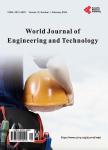Numerical Study of Slip Effect of Unsteady MHD Pulsatile Flow through Porous Medium in an Artery Using Generalized Differential Quadrature Method (Comparative Study)
Numerical Study of Slip Effect of Unsteady MHD Pulsatile Flow through Porous Medium in an Artery Using Generalized Differential Quadrature Method (Comparative Study)作者机构:Department of Basic Engineering Sciences Faculty of Engineering Menofia University Shebien El-Kom Egypt Department of Engineering Mathematics and Physics Faculty of Engineering Cairo University Giza Egypt
出 版 物:《World Journal of Engineering and Technology》 (世界工程和技术(英文))
年 卷 期:2014年第2卷第2期
页 面:131-148页
学科分类:07[理学] 0701[理学-数学] 070101[理学-基础数学]
主 题:Pulsatile Blood Flow Magnetic Field Body Acceleration Porous Medium Differential
摘 要:The unsteady pulsatile flow of blood through porous medium in an artery has been studied under the influence of periodic body acceleration and slip condition by considering blood as incompressible Newtonian electrically conducting fluid in the presence of magnetic field. In this paper, a new technique of differential quadrature method is introduced to find numerical solution of non-linear partial differential equations such as the equation of motion of this problem “Navier-Stokes equation. The presence of the nonlinearity in the problem leads to severe difficulties in the solution approximation. In construction of the numerical scheme “a new algorithm a generalized differential quadrature method (GDQM) is to use for derivatives with respect to space variables of differential equations and for the time derivative applying fourth order RungeKutta Method (RKM). The GDQM changed the nonlinear partial differential equations into a system of nonlinear ordinary differential equations (ODEs). The obtained system of ODEs is solved by 4th order RKM. This combination of DQM and 4th order RKM gives a very good numerical technique for solving time dependent problems. The algorithm is coded in Matlab 7.***.0.739 and the simulations are run on a Pentium 4 CPU 900 MHz with 1 GB memory capacity. The effects of slip condition, magnetic field, porous medium, and body acceleration have been discussed. The numerical results show that the proposed method is more accurate and convergent than other numerical methods in literature. The method is illustrated and compared with the exact and analytical solutions and it is found that the proposed method gives a better accuracy and is quite easy to implement.



